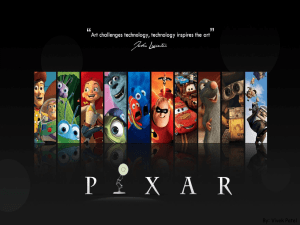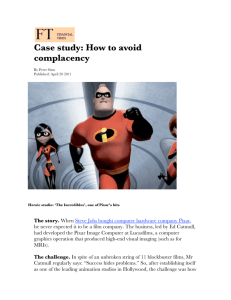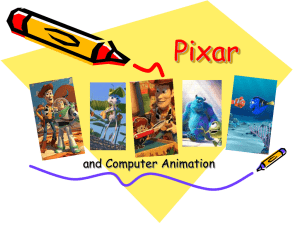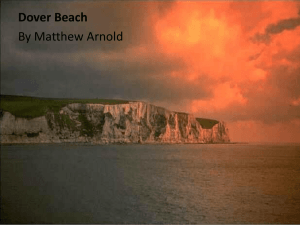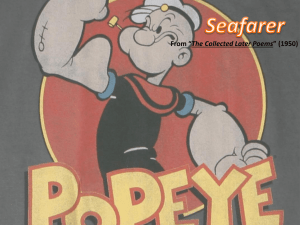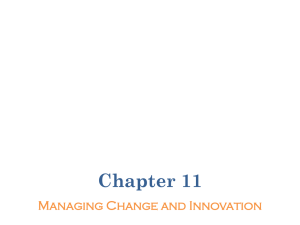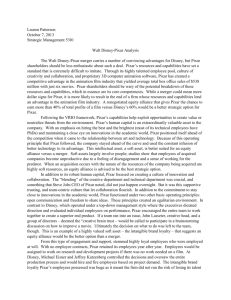A Tall Order for Pixar Shorts: Helping Students to Move Beyond the
advertisement
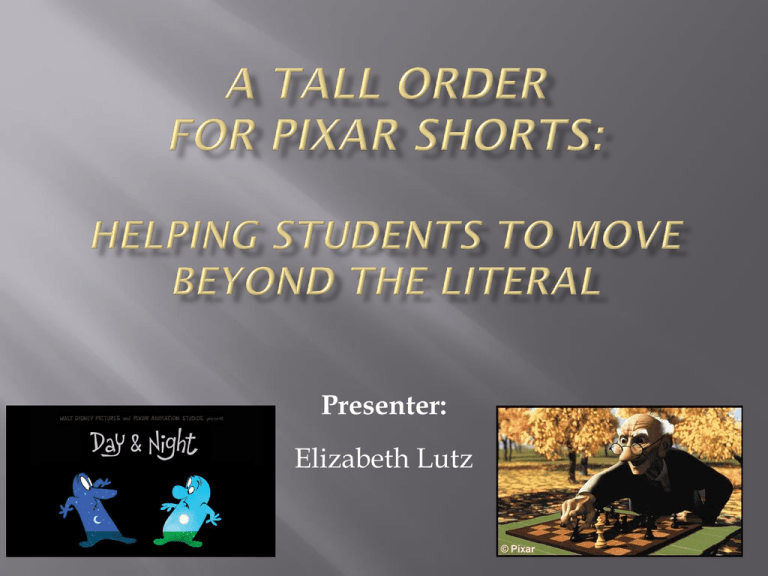
Presenter: Elizabeth Lutz Introduction to Poetry by Billy Collins I ask them to take a poem and hold it up to the light like a color slide or press an ear against its hive. I say drop a mouse into a poem and watch him probe his way out, or walk inside the poem’s room and feel the walls for a light switch. I want them to waterski across the surface of a poem waving at the author’s name on the shore. But all they want to do is tie the poem to a chair with rope and torture a confession out of it. They begin beating it with a hose to find out what it really means. How do we help students to find meaning in texts without “torturing confessions” out of them? (moving away from one-meaning thinking) These methods will help students to feel comfortable feeling around for the light switch – being comfortable not knowing. Finding meaning is useful in literature and beyond – students also need to become critical consumers of popular culture. We will use Pixar Shorts and their multi-layered stories as a bridge to various analytical techniques in order to help students move beyond the literal. 1. 2. 3. 4. 5. 6. Introduction Notice and Focus Technique (…or how to avoid jumping to judgments while also identifying points for analysis) Applying Notice and Focus to Day and Night Ideas for use in literature units Horizontal and Vertical Movement in La Luna Further applications Why Pixar? Why this short? You can begin the lesson with a screen shot – having the students track everything they notice. (see handout for this option) You can also skip to the first viewing of the film, asking students to list observations. Borrowed from Writing Analytically by David Rosenwasser and Jill Stephen Simple technique that can be applied to so many classroom projects - film notes, image analysis, close textual analysis of fiction and non-fiction, and discussion preparation. Helps students to “feel for a light switch” I have had students tell me that this technique works for all of their classes…even when studying a science textbook. Step 1 List at least ten things that seem important. Don’t make judgments about them (yet) or try to figure out why they are important. Just list. You might write down a quote or a moment or an idea. It could just be one word. This step provides freedom – students don’t need to have any answers as to why things are important. They are just observing. Step 2 Rank your list in order of most important to least important. Settle on the top three most important items. Step 3 For each of the three most important items, write a brief paragraph exploring what each detail might contribute to the meaning of the piece. Look at it from different angles and try to identify why it might matter. For every idea you come up with, answer the question “So what?”. Rosenwasser, David, and Jill Stephen. Writing Analytically. 6th ed. Boston: Cengage Learning, 2012. Print While watching the film, notice ten things related to perspective (it is helpful to give students a subject to guide their thinking). Before continuing to other steps, it is useful to have volunteers read some of their observations (students are often surprised at how meaningful the minute details might seem). Students then rank their observations. It is useful to have them do this with a partner because it sparks debate about what matters in the film. Please turn to your neighbors and discuss the top two most important items from your list. The third step (Analysis) requires a bit of explanation to students. They need to understand that this is where they answer the “Why?” and “So what?” questions. Why is that detail important? What does it contribute to the meaning of the whole text? So what? Students are now able to utilize this technique as a way of analyzing so many other things: chapters in a novel. a passage from a text, non-fiction essay, fil m clip, image, peer essay (a peer editing session), poem We often use Pixar Shorts in classes because they are both engaging and complex at the same time. We have included here some of the ways that we have used Day and Night along with some of the other films in their collection. Day and Night Introduce the idea of varying perspectives – explore the idea of “other” before reading a text like Night by Elie Wiesel and identify how the characters in the short film are finally able to see the perspective of the other Have students rename “Day” and “Night” using characters from a text. Create blank templates of the Day and Night bodies so that students can draw in the things their characters might see as “other” Do a close reading of the spoken lines in the middle of the short. The only spoken lines are from a 1970’s lecture by Dr. Wayne Dyer and are reminiscent of a similar speech by Albert Einstein. Have students identify texts, situations, characters, or personal experiences that these words speak to. “Fear of the unknown. They are afraid of new ideas. They are loaded with prejudices, not based upon anything in reality, but based on… if something is new, I reject it immediately because it’s frightening to me. What they do instead is just stay with the familiar. You know, to me, the most beautiful things in all the universe, are the most mysterious.” Most Pixar Shorts are great examples of how a short text can be filled with meaning. La Luna is an excellent example of this. Its horizontal movement (plot/action) is short and simple: a young boy working with his father and grandfather. Yet its vertical movement – possible meanings, use of literary elements, questions raised – is quite rich. Pay attention to the details! Understanding of creator’s intentionality Understanding of vertical movement. Horizontal – similar to “Notice” Vertical – similar to “Focus” Notice Focus (so what?) The boy is given a hat identical to his father’s and grandfather’s. He is just like them (or they want him to be just like them). Noting literary elements under horizontal movement. Further questions – now that students have looked at horizontal and vertical movement… Why are the differences between the father and grandfather emphasized? How is generational tension explored? What was left out? What information was not provided? Why? For students, the reading experience is about what happens – the plot. Encourage attention to details Writing in-depth about short texts Apply horizontal-vertical movement to short written text: Flash fiction or flash non-fiction Poetry Very short stories, e.g. “The Story of an Hour” (Kate Chopin) Prep for writing analysis Similar to their reading practices, students tend to focus on plot when writing their own stories, poetry, or other creative genre. After watching a Pixar Short and examining its horizontal and vertical movement, students can apply these concepts to their own writing. I encourage my students to limit the scope of their writing and increase its depth, or vertical movement. Possible Activities Provide students with several brief moments, e.g. a girl slaps a boy; a daughter cries on her mother’s shoulder; a boy scores a touchdown. Students choose one of the moments and come up with possible “vertical movement” – possible meanings or themes that could arise from that moment. Students sketch out full plots for a story, from exposition to resolution. The story should revolve around a central theme. Then students narrow the scope, or horizontal movement, of the story, to the key moment that contains the most thematic depth. They then write the story about that moment, focusing on developing vertical movement.


